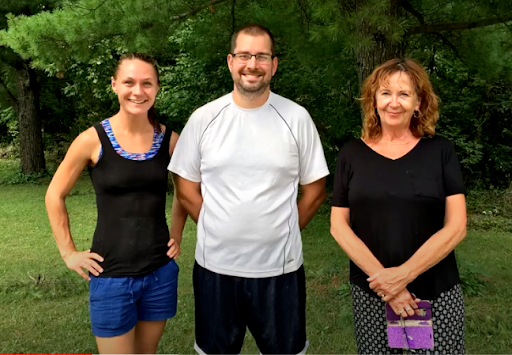An assistant dean reflects on the role of academic administrations in advancing community science
For environmental chemist Christopher Spiese, PhD, science doesn’t stop in the lab. “If I think about my scientific heroes, I think about people who did excellent science in the lab and brought it out into the wider world,” says Spiese, Assistant Dean and Associate Professor of Chemistry at Ohio Northern University.
So, when he was approached about pitching in on a project to help residents in Cambridge, Ohio understand potential environmental issues posed by nearby unconventional oil and gas development (fracking) activities, he jumped at the chance. Soon enough, he found himself signing on to serve as scientific partner on a second Thriving Earth project, this time in Youngstown, Ohio.
A refreshing experience

Spiese, center, with Cambridge, Ohio, collaborators Leatra Harper and Emily Richards
As a teaching-focused faculty member (and now administrator) at a primarily undergraduate institution, Spiese says working with communities to better understand how what’s in their water and how it affects their lives has been an inspiring experience both professionally and personally.
“One of the things I really enjoy about it is being able to get out there with scientific peers again,” he says. “In my current position, I don’t get to necessarily interface with people who are doing research all the time. It’s been a wonderful refresher on why I got into this field in the first place.”
Adjusting expectations
While the experience has been positive, it’s not without challenges. Without graduate students to help out, only a token amount of budget from his institution and very little of his time allocated to the projects, Spiese says, “I had to learn pretty quickly to scale my contributions and commitments appropriately.”
The community science approach resonates with Spiese’s teaching style, and he initially hoped to involve students in the projects. But he’s found it challenging to get students on board, especially since most student projects happen on a semester-by-semester basis. On the other hand, Spiese says he’s been more successful in piquing the interest of fellow faculty members, bringing in collaborators from statistics, civil engineering and other fields.
A growing movement
Fields like healthcare and public health have a long history of valuing and rewarding community service and engagement. More recently, Spiese says energy is building for community-engaged, impact-focused work in fields like sustainability and environmental science. As an administrator, he says it’s incumbent on universities to listen to these trends and give students meaningful opportunities to pursue their passions.
“We have to understand that Gen Z and future generations are going to be much more environmentally conscious,” he says. “This century is the century of climate change and all these other environmental issues, and we need to train scientists and young people in those issues and how to address them.”
In addition to training the next generation of scientists and citizens, Spiese notes that institutions of higher education have a responsibility to the broader community. Bringing their expertise beyond campus to address community priorities helps fulfill this role while also improving the institution’s visibility and impact.
“We get federal dollars on this premise that we’re going to train and help to serve. This is a great way to do that [service] part of our mission,” he says. “And, from an administrator’s perspective, it also is a great way to get your institution’s name out there in a good, positive light.”
Institutional shifts
Despite the benefits, community-engaged science is still often seen as a “side project,” somehow lesser than the traditional R01 grant-funded work most academic careers are built around. As such, many faculty members have been dissuaded from community science, fearful it will hinder their professional advancement. Spiese says he is gratified to see these attitudes are beginning to change, albeit gradually.
“It may not be a monumental shift, but I think we are seeing a greater appreciation for scientists who get out of the lab and make a difference in the world,” he says. “Especially at the undergraduate level, we’re starting to see that this sort of work is, perhaps not always rewarded, but less penalized—there’s a growing awareness that it has benefits to the institution.”
To Spiese, it’s clear that community science has benefits for institutions, communities and individual faculty members. But to grow this movement further will require shifts in both attitudes and structures. While a “stick-based” approach is not likely to be helpful, he says removing barriers and providing “carrots” at the faculty level could have a real impact.
“If administrators want to have their faculty go out and do stuff like Thriving Earth Exchange, they have to be very explicit that it contributes to tenure and promotion, that it matters for annual evaluations,” he says. “If you build that in and incentivize and support it, you’ll see a greater proportion of people jumping into that realm.”
Learn more about serving as a scientific partner with Thriving Earth Exchange. Want more scientist stories? Read reflections from scientists working with communities on plastic pollution and flooding.
